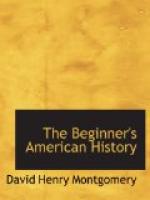[Footnote 3: Sebastian (Se-bast’yan).]
[Footnote 4: Breton (Bret’on).]
[Footnote 5: Nova Scotia (No’vah Sko’she-a).]
[Footnote 6: The Northmen: an uncivilized people of Norway and Denmark discovered the continent of North America about five hundred years before Cabot did. Nothing came of this discovery, and when Cabot sailed, no one seems to have known anything about what the Northmen had done so long before.]
22. John Cabot takes possession of the country for the king of England.—Cabot went on shore with his son and some of his crew. In the vast, silent wilderness they set up a large cross. Near to it they planted two flag-poles, and hoisted the English flag on one and the flag of Venice,[7] the city where John Cabot had lived in Italy, on the other. Then they took possession of the land for Henry the Seventh. It was in this way that the English came to consider that the eastern coast of North America was their property, although they did not begin to make settlements here until nearly a hundred years later.
[Illustration: Landing of the Cabots.]
[Footnote 7: Venice (Ven’is).]
23. John Cabot and his son return to Bristol.—After sailing about the Gulf of St. Lawrence without finding the passage through to Asia for which they were looking, the voyagers returned to England.
The king was so pleased with what John Cabot had discovered that he made him a handsome present; and when the captain, richly dressed in silk, appeared in the street, the people of Bristol would “run after him like mad” and hurrah for the “Great Admiral,” as they called him.
24. What the Cabots carried back to England from America.—The Cabots carried back to England some Indian traps for catching game and perhaps some wild turkeys—an American bird the English had then never seen, but whose acquaintance they were not sorry to make. They also carried over the rib of a whale which they had found on the beach in Nova Scotia.
Near where the Cabots probably lived in Bristol there is a famous old church.[8] It was built long before the discovery of America, and Queen Elizabeth said that it was the most beautiful building of its kind in all England. In that church hangs the rib of a whale. It is believed to be the one the Cabots brought home with them. It reminds all who see it of that voyage in 1497 by which England got possession of a very large part of the continent of North America.
[Footnote 8: The church of St. Mary Redcliffe.]
25. The second voyage of the Cabots; how they sailed along the eastern shores of North America.—About a year later the Cabots set out on a second voyage to the west. They reached the gloomy cliffs of Labrador[9] on the northeastern coast of America, and they passed many immense icebergs. They saw numbers of Indians dressed in the skins of wild beasts, and polar bears white as snow. These bears were great




